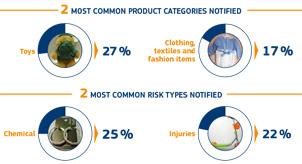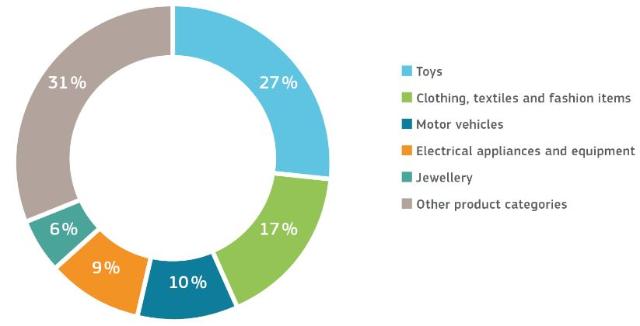EU News
|
|
Protecting European consumers: toys & clothing top the list of dangerous products detected in 2015
The European Commission published new figures yesterday showing that, in 2015, more than 2,000 dangerous products triggered EU-wide alerts. A key challenge is the increasing share of products bought online from outside the EU.
© European Union 2015
The Commission, EU Member States and businesses are working together to ensure that these unsafe consumer goods are removed from the European market.
"The Rapid Alert system has helped coordinate quick reactions between consumer protection authorities to remove dangerous products across Europe. Two challenges lie ahead of us: online sales bringing products directly to consumer's houses through mail and the strong presence of Chinese products signalled through the Rapid Alert system. I'm going to China in June to further step up our important cooperation with the Chinese authorities on product safety." said Věra Jourová, EU Commissioner for Justice, Consumers and Gender Equality.
In 2015, there were 2,072 alerts and 2,745 follow-up actions registered in the system. When one Member State posts an alert on the system, other countries can spot the product on their market and react to this initial alert.
Over 65% of Europeans buy products online and the number of online shoppers has grown by 27% between 2006 and 2015. A new challenge is now to address the online channel, which also brings products from outside the EU through mail into consumers’ households that may not have been subjected to safety verification.
The Commission is working on further improving the Rapid Alert system to include this aspect. We've already seen successful cooperation with border control staff and online selling platforms. We will ensure further focus on online sales, as part of the Commission’s international product safety agenda.
Which products are posing risks?
In 2015, toys (27%) and clothing, textiles and fashion items (17%) were the two main product categories for which corrective measures had to be taken. These were already the most notified products the year before. As far as risks are concerned, in 2015, the most frequently notified risk (25% of the total of the notifications) was chemical risk, followed bythe risk of injuries (22%), which was at the top of the list in the previous report.
The most frequent chemical risks notified in 2015 related to products such as fashion jewellery, with harmful heavy metals like nickel and lead, and toys containing phthalates (plastic softeners which can cause fertility problems).
Where are they coming from?
With 62% of the notified dangerous products coming from China, this country remains the number one country of origin in the alert system. It is the EU's largest source of imports.
Collaboration with the Chinese authorities continues to be a priority for the EU and, more specifically, takes place within the Rapid Alert System China mechanism: each notification concerning a product of Chinese origin is sent to the Chinese administration, so that they address the issue with the manufacturer or exporter directly if these economic operators are traceable.
To date, China has followed up on as many as 11,540 notifications and has been able to take corrective measures in 3,748 cases. In many cases, tracing the source of the product remains difficult.
Commissioner Jourovà will visit China in June to discuss product safety with her Chinese counterparts.
Background
Since 2003, the Rapid Alert system ensures that information about dangerous non-food products withdrawn from the market and/or recalled anywhere in Europe is quickly circulated between Member States and the European Commission. This way, appropriate follow-up action (ban/stop of sales, withdrawal, recall or import rejection by Customs authorities) can be taken everywhere in the EU.
Thirty-one countries (EU together with Iceland, Liechtenstein and Norway) currently participate in the system. The Rapid Alert System functions thanks to daily and continuous cooperation between Member States.
The Rapid Alert system in numbers

For more information, please see:
Rapid Alert system search page
Rapid Alert system weekly reports
Rapid Alert sytem national contact points
More information on the Rapid Alert system
Graph 1: Most common notified product categories

Graph 2: Notifications in 2015 signalling a chemical risk by product category

Graph 3: Notifications in 2014 and 2015 by groups of countries of origin

Press contacts:
- Melanie VOIN (+ 32 2 295 86 59)
- Christian WIGAND (+32 2 296 22 53)
General public inquiries: Europe Direct by phone 00 800 67 89 10 11 or by email


